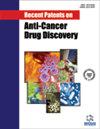TPD52 as a Potential Prognostic Biomarker and its Correlation with Immune Infiltrates in Uterine Corpus Endometrial Carcinoma: Bioinformatic Analysis and Experimental Verification
IF 2.5
4区 医学
Q3 ONCOLOGY
Recent patents on anti-cancer drug discovery
Pub Date : 2024-02-02
DOI:10.2174/0115748928267447231107101539
引用次数: 0
Abstract
Background: Aberrant expression of tumor protein D52 (TPD52) is associated with some tumors. The role of TPD52 in uterine corpus endometrial carcinoma (UCEC) remains uncertain. Objective: We aimed to investigate the involvement of TPD52 in the pathogenesis of UCEC. Methods: We employed bioinformatics analysis and experimental validation in our study. Results: Our findings indicated that elevated TPD52 expression in UCEC was significantly associated with various clinical factors, including clinical stage, race, weight, body mass index (BMI), histological type, histological grade, surgical approach, and age (p < 0.01). Furthermore, high TPD52 expression was a predictor of poorer overall survival (OS), progress-free survival (PFS), and disease-specific survival (DSS) (p = 0.011, p = 0.006, and p = 0.003, respectively). TPD52 exhibited a significant correlation with DSS (HR: 2.500; 95% CI: 1.153-5.419; p = 0.02). TPD52 was involved in GPCR ligand binding and formation of the cornified envelope in UCEC. Moreover, TPD52 expression was found to be associated with immune infiltration, immune checkpoints, tumor mutation burden (TMB)/ microsatellite instability (MSI), and mRNA stemness indices (mRNAsi). The somatic mutation rate of TPD52 in UCEC was 1.9%. A ceRNA network of AC011447.7/miR-1-3p/TPD52 was constructed. There was excessive TPD52 protein expression. The upregulation of TPD52 expression in UCEC cell lines was found to be statistically significant. Conclusion: TPD52 is upregulated in UCEC and may be a useful patent for prognostic biomarkers of UCEC, which may have important value for clinical treatment and supervision of UCEC patients.作为潜在预后生物标记物的 TPD52 及其与子宫体子宫内膜癌免疫浸润的相关性:生物信息学分析与实验验证
背景:肿瘤蛋白 D52(TPD52)的异常表达与某些肿瘤有关。TPD52 在子宫内膜癌(UCEC)中的作用仍不确定。研究目的我们旨在研究 TPD52 在 UCEC 发病机制中的参与作用。方法我们在研究中采用了生物信息学分析和实验验证。结果我们的研究结果表明,TPD52在UCEC中的高表达与各种临床因素显著相关,包括临床分期、种族、体重、体重指数(BMI)、组织学类型、组织学分级、手术方式和年龄(p <0.01)。此外,TPD52的高表达可预测较差的总生存期(OS)、无进展生存期(PFS)和疾病特异性生存期(DSS)(分别为p = 0.011、p = 0.006和p = 0.003)。TPD52 与 DSS 呈显著相关性(HR:2.500;95% CI:1.153-5.419;p = 0.02)。TPD52 参与了 UCEC 中 GPCR 配体的结合和粟粒状包膜的形成。此外,还发现TPD52的表达与免疫浸润、免疫检查点、肿瘤突变负荷(TMB)/微卫星不稳定性(MSI)和mRNA干性指数(mRNAsi)有关。UCEC 中 TPD52 的体细胞突变率为 1.9%。构建了AC011447.7/miR-1-3p/TPD52的ceRNA网络。TPD52蛋白表达量过大。发现 TPD52 在 UCEC 细胞系中的表达上调具有统计学意义。结论TPD52在UCEC中上调,可能是UCEC预后生物标志物的有效专利,对UCEC患者的临床治疗和监护具有重要价值。
本文章由计算机程序翻译,如有差异,请以英文原文为准。
求助全文
约1分钟内获得全文
求助全文
来源期刊
CiteScore
4.50
自引率
7.10%
发文量
55
审稿时长
3 months
期刊介绍:
Aims & Scope
Recent Patents on Anti-Cancer Drug Discovery publishes review and research articles that reflect or deal with studies in relation to a patent, application of reported patents in a study, discussion of comparison of results regarding application of a given patent, etc., and also guest edited thematic issues on recent patents in the field of anti-cancer drug discovery e.g. on novel bioactive compounds, analogs, targets & predictive biomarkers & drug efficacy biomarkers. The journal also publishes book reviews of eBooks and books on anti-cancer drug discovery. A selection of important and recent patents on anti-cancer drug discovery is also included in the journal. The journal is essential reading for all researchers involved in anti-cancer drug design and discovery. The journal also covers recent research (where patents have been registered) in fast emerging therapeutic areas/targets & therapeutic agents related to anti-cancer drug discovery.

 求助内容:
求助内容: 应助结果提醒方式:
应助结果提醒方式:


